PHP - Decision Making
The if, elseif ...else and switch statements are used to take decision based on the different condition.You can use conditional statements in your code to make your decisions. PHP supports following three decision making statements −

- if...else statement − use this statement if you want to execute a set of code when a condition is true and another if the condition is not true
- elseif statement − is used with the if...else statement to execute a set of code if one of the several condition is true
- switch statement − is used if you want to select one of many blocks of code to be executed, use the Switch statement. The switch statement is used to avoid long blocks of if..elseif..else code.
The If...Else Statement
If you want to execute some code if a condition is true and another code if a condition is false, use the if....else statement.Syntax
if (condition) code to be executed if condition is true; else code to be executed if condition is false;
Example
The following example will output "Have a nice weekend!" if the current day is Friday, Otherwise, it will output "Have a nice day!":<html> <body> <?php $d = date("D"); if ($d == "Fri") echo "Have a nice weekend!"; else echo "Have a nice day!"; ?> </body> </html>It will produce the following result −
Have a nice day!
The ElseIf Statement
If you want to execute some code if one of the several conditions are true use the elseif statementSyntax
if (condition) code to be executed if condition is true; elseif (condition) code to be executed if condition is true; else code to be executed if condition is false;
Example
The following example will output "Have a nice weekend!" if the current day is Friday, and "Have a nice Sunday!" if the current day is Sunday. Otherwise, it will output "Have a nice day!" −<html> <body> <?php $d = date("D"); if ($d == "Fri") echo "Have a nice weekend!"; elseif ($d == "Sun") echo "Have a nice Sunday!"; else echo "Have a nice day!"; ?> </body> </html>It will produce the following result −
Have a nice day!
The Switch Statement
If you want to select one of many blocks of code to be executed, use the Switch statement.The switch statement is used to avoid long blocks of if..elseif..else code.
Syntax
switch (expression){
case label1:
code to be executed if expression = label1;
break;
case label2:
code to be executed if expression = label2;
break;
default:
code to be executed
if expression is different
from both label1 and label2;
}
Example
The switch statement works in an unusual way. First it evaluates given expression then seeks a lable to match the resulting value. If a matching value is found then the code associated with the matching label will be executed or if none of the lable matches then statement will execute any specified default code.<html> <body> <?php $d = date("D"); switch ($d){ case "Mon": echo "Today is Monday"; break; case "Tue": echo "Today is Tuesday"; break; case "Wed": echo "Today is Wednesday"; break; case "Thu": echo "Today is Thursday"; break; case "Fri": echo "Today is Friday"; break; case "Sat": echo "Today is Saturday"; break; case "Sun": echo "Today is Sunday"; break; default: echo "Wonder which day is this ?"; } ?> </body> </html>It will produce the following result −
Today is Monday
PHP - Loop Types
Loops in PHP are used to execute the same block of code a specified number of times. PHP supports following four loop types.- for − loops through a block of code a specified number of times.
- while − loops through a block of code if and as long as a specified condition is true.
- do...while − loops through a block of code once, and then repeats the loop as long as a special condition is true.
- foreach − loops through a block of code for each element in an array.
The for loop statement
The for statement is used when you know how many times you want to execute a statement or a block of statements.
Syntax
for (initialization; condition; increment){
code to be executed;
}
The initializer is used to set the start value for the counter of the
number of loop iterations. A variable may be declared here for this
purpose and it is traditional to name it $i.Example
The following example makes five iterations and changes the assigned value of two variables on each pass of the loop −<html> <body> <?php $a = 0; $b = 0; for( $i = 0; $i<5; $i++ ) { $a += 10; $b += 5; } echo ("At the end of the loop a = $a and b = $b" ); ?> </body> </html>This will produce the following result −
At the end of the loop a = 50 and b = 25
The while loop statement
The while statement will execute a block of code if and as long as a test expression is true.If the test expression is true then the code block will be executed. After the code has executed the test expression will again be evaluated and the loop will continue until the test expression is found to be false.

Syntax
while (condition) {
code to be executed;
}
Example
This example decrements a variable value on each iteration of the loop and the counter increments until it reaches 10 when the evaluation is false and the loop ends.<html> <body> <?php $i = 0; $num = 50; while( $i < 10) { $num--; $i++; } echo ("Loop stopped at i = $i and num = $num" ); ?> </body> </html>This will produce the following result −
Loop stopped at i = 10 and num = 40
The do...while loop statement
The do...while statement will execute a block of code at least once - it then will repeat the loop as long as a condition is true.Syntax
do {
code to be executed;
}
while (condition);
Example
The following example will increment the value of i at least once, and it will continue incrementing the variable i as long as it has a value of less than 10 −<html> <body> <?php $i = 0; $num = 0; do { $i++; } while( $i < 10 ); echo ("Loop stopped at i = $i" ); ?> </body> </html>This will produce the following result −
Loop stopped at i = 10
The foreach loop statement
The foreach statement is used to loop through arrays. For each pass the value of the current array element is assigned to $value and the array pointer is moved by one and in the next pass next element will be processed.Syntax
foreach (array as value) {
code to be executed;
}
Example
Try out following example to list out the values of an array.<html> <body> <?php $array = array( 1, 2, 3, 4, 5); foreach( $array as $value ) { echo "Value is $value <br />"; } ?> </body> </html>This will produce the following result −
Value is 1 Value is 2 Value is 3 Value is 4 Value is 5
The break statement
The PHP break keyword is used to terminate the execution of a loop prematurely.The break statement is situated inside the statement block. If gives you full control and whenever you want to exit from the loop you can come out. After coming out of a loop immediate statement to the loop will be executed.

Example
In the following example condition test becomes true when the counter value reaches 3 and loop terminates.<html> <body> <?php $i = 0; while( $i < 10) { $i++; if( $i == 3 )break; } echo ("Loop stopped at i = $i" ); ?> </body> </html>This will produce the following result −
Loop stopped at i = 3
The continue statement
The PHP continue keyword is used to halt the current iteration of a loop but it does not terminate the loop.Just like the break statement the continue statement is situated inside the statement block containing the code that the loop executes, preceded by a conditional test. For the pass encountering continue statement, rest of the loop code is skipped and next pass starts.

Example
In the following example loop prints the value of array but for which condition becomes true it just skip the code and next value is printed.<html> <body> <?php $array = array( 1, 2, 3, 4, 5); foreach( $array as $value ) { if( $value == 3 )continue; echo "Value is $value <br />"; } ?> </body> </html>This will produce the following result −
Value is 1 Value is 2 Value is 4 Value is 5
No comments:
Post a Comment